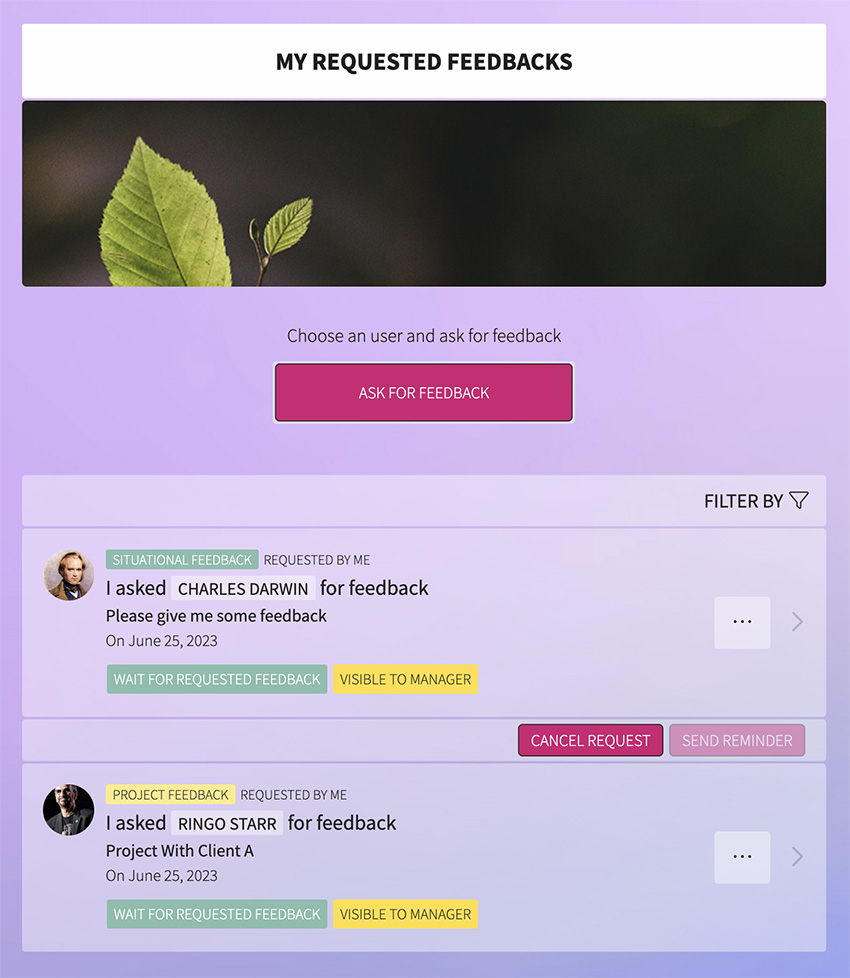What is employee feedback?
Employee feedback refers to the process of gathering, analyzing, and acting upon the opinions, insights, and suggestions provided by employees and their managers about their workplace experiences, job responsibilities, and overall satisfaction.
In this article about Employee Feedback – complete guide with real examples, you will find useful information to improve the performance of your employees.
The importance of Employee Feedback
Employee feedback is a key part of any business. In fact, it’s crucial for success. By using an employee feedback surveys, you can easily understand how your employees feel. They might share feelings about their work, their bosses, or the overall company. Simple employee feedback tools, like employee feedback software, help in this process. This way, you can boost their happiness, do better work, and keep everyone engaged.
 How to collect employee feedback?
How to collect employee feedback?
Employee feedback is essential for any business that wants to improve its performance. There are many different ways to collect employee feedback, but some of the most effective methods include:
- Surveys
- One-on-one meetings
- Suggestion boxes
The Gfoundry platform can be used to collect employee feedback in a variety of ways. For example, you can use the platform to create surveys, one-on-one meetings, and suggestion boxes. You can also use the platform to track and analyze employee feedback, so you can see how your company is doing over time.
Here are some tips for collecting employee feedback:
- Use clear and concise questions: Your questions should be clear and concise, so employees can easily understand what you are asking.
- Offer multiple choice answers: Offering multiple choice answers will make it easier for employees to provide feedback.
- Allow for anonymous feedback: Some employees may not be comfortable providing feedback if they know their identity will be revealed.
- Track and analyze feedback: Track and analyze employee feedback so you can see how your company is doing over time.
 Main Feedback Models
Main Feedback Models
What is SCI Feedback?
The SCI Feedback model (Situation, Behavior, Impact) is an effective and widely used feedback tool. It’s a simple, yet powerful framework that allows for clear and objective communication to help improve performance and behavior in the workplace. Let’s delve deeper into each component of the model.
- Situation: This is the first step of SCI feedback. Here, you describe the specific situation in which the behavior occurred. It’s crucial to be as precise as possible so that the person receiving the feedback can clearly understand the context. For example, instead of saying “in the meeting”, you might say “in last Tuesday’s planning meeting”.
- Behavior: Next, you address the specific behavior you want to discuss. Again, it’s important to be clear and specific, focusing on observable actions and avoiding judgments or assumptions. For instance, rather than saying “you were disrespectful”, you might say “you interrupted while others were speaking”.
- Impact: Finally, you describe the impact of the behavior. This could be the effect on you, on others, on the team, or on the project as a whole. Discussing the impact helps the person understand the consequences of their behavior and why it’s important to make a change. For instance, you could say, “It made others feel undervalued and disrupted the flow of the discussion”.
Using the SCI feedback model can make the experience of giving and receiving feedback less personal and more productive, focusing on specific behaviors and their impacts. It helps create a more open and supportive work environment where everyone is committed to continuous improvement.
What is 360º Feedback?
360º feedback is a technique where an individual receives feedback from various sources – including superiors, peers, subordinates, and even customers. This approach provides a more comprehensive and balanced view of an individual’s performance, which is much more valuable than the perspective of just one person.
What is Sandwich Feedback?
Sandwich feedback is a technique that involves starting and ending feedback with positive comments, with constructive criticism in the middle. However, it’s important to use it with caution. If not done well, it can be seen as insincere or confusing. Also, some people might only hear the positive comments and overlook the criticism.
What is the Feedback Canvas?
The Feedback Canvas is a visual tool that helps provide comprehensive and balanced feedback. It encourages the person to consider all aspects of an individual’s performance, including strengths, areas for improvement, external influences, and personal aspirations.
The Feedback Canvas is divided into several sections, each representing a different aspect of feedback:
- What was done well: This section highlights areas where the individual or team performed well. It’s an opportunity to recognize strengths and successes.
- What could be improved: This section identifies areas that need improvement. It’s a chance to provide constructive criticism and suggest ways to get better.
- Ideas and suggestions: This section is for sharing ideas and suggestions for the future. It’s an opportunity to think creatively and innovatively.
- Actions to be taken: This section describes the specific actions that will be taken based on the feedback. It’s an action plan that helps turn feedback into real improvements.
What is Kudos Feedback?
Kudos feedback is an effective way to recognize and appreciate the efforts and achievements of employees. It encourages positive recognition and creates a culture of appreciation in the workplace. The term “Kudos” is derived from ancient Greek and is used to express praise or recognition for a job well done.
“Kudos Feedback” can be given in various ways, such as a personal thank you, a compliment in front of the team, or through a formal recognition system.
What is the Feedback Wall?
A Feedback Wall is a physical or virtual space where people can post feedback anonymously. This can encourage participation from individuals who might hesitate to give face-to-face feedback. However, it’s important to monitor the feedback to ensure that it’s constructive and respectful.
 The Biggest Trends in Feedback
The Biggest Trends in Feedback
Feedback Feedforward
What is Feedback feedforward?
Feedback Feedforward is a methodology and communication strategy that focuses on the future instead of the past. While traditional feedback focuses on what has already happened, feedforward focuses on what can be improved in the future.
Feedforward is gaining ground in the corporate world as a more productive method of improving employee performance. Instead of looking back and criticizing what has already happened, this proactive approach focuses on providing suggestions for future improvements. With a more positive and future-oriented tone, feedforward can be less defensive and more accepted by employees, encouraging them to adopt new behaviors and strategies to achieve their goals.
One-on-one Feedback (1:1)
What is One-on-one feedback (1:1)?
One-on-one feedback (1:1) is a type of workplace communication that occurs directly between two individuals, typically a manager and a team member. These meetings are designed to provide an opportunity to give and receive feedback, discuss goals and objectives, solve problems, and deepen the working relationship.
One-on-one feedback meetings are becoming increasingly popular as a way to provide personalized and in-depth feedback. These private meetings between a manager and a team member offer an opportunity to discuss the employee’s performance in detail, set clear goals, and address any issues or concerns openly and honestly. They create a safe space for meaningful dialogue, strengthening the work relationship and allowing for more effective personal and professional development.
Continuous Feedback
What is continuous feedback?
Continuous feedback is a workplace communication method where feedback is given regularly, rather than at fixed intervals like in annual performance evaluations.
The practice of continuous feedback is another trend that is transforming the way companies manage employee performance. Instead of relying on annual performance evaluations, many organizations encourage a constant flow of feedback between managers and employees. This allows for issues to be identified and resolved quickly, for accomplishments to be recognized in real-time, and for employees to receive ongoing support for their development.
 The Power and Efficacy of the Continuous Feedback Loop
The Power and Efficacy of the Continuous Feedback Loop
What is Continuous Feedback Loop?
The continuous feedback loop is a concept derived from systems theory, emphasizing the cyclical nature of input, action, and reaction. When applied to organizations, it offers insights on improvement, adaptability, and performance optimization.
Why adopt continuous feedback?
- Rapid Adaptation: Quick adjustments based on constant feedback help organizations stay relevant and effective.
- Employee Engagement and Morale: Frequent feedback can provide employees with clarity, motivation, and a sense of purpose.
- Continuous Learning and Improvement: Iterative feedback promotes consistent growth and innovation.
What is the structure of an effective feedback loop?
- Collecting Feedback: Utilizing tools, surveys, one-on-ones, and other methods to gather relevant data.
- Analyzing Feedback: Making sense of the feedback, finding patterns, and identifying areas of concern or improvement.
- Implementing Changes: Taking actionable steps based on the insights derived from the feedback.
- Reviewing the Impact: Assessing the outcomes of changes to ensure they’re effective and refining accordingly.
What are the Best Practices in Continuous Feedback?
- Open Communication Channels: Ensuring employees at all levels feel safe and encouraged to provide honest feedback.
- Regular Review Cycles: Setting up periodic check-ins and reviews to keep the loop running efficiently.
- Using Technology: Leveraging modern software and tools to streamline feedback collection and analysis.
- Training Managers: Equipping leadership with the skills to give and receive constructive feedback.
How to analyze employee feedback?
The Gfoundry platform can help you to analyze employee feedback in a number of ways. First, the platform allows you to collect feedback from employees in a variety of formats, including open-ended questions, multiple choice questions, and rating scales. This gives you the flexibility to collect the feedback that is most relevant to your needs.
Here are some additional tips for analyzing employee feedback:
- Look for patterns and trends. What are the most common themes in the feedback that you receive? Are there any specific areas where employees are consistently expressing dissatisfaction?
- Compare feedback across different groups of employees. Are there any differences in the way that different groups of employees feel about their work? For example, do younger employees have different expectations than older employees?
- Use the feedback to identify areas for improvement. What specific changes can you make to improve the work environment for your employees?
- Communicate the results of the feedback analysis to employees. Let employees know what you have learned from the feedback and what you are doing to address their concerns.
You can use our feedback module completely free of charge now.
Positive and Negative Feedback Examples:
Employee performance feedback
- Exceptional performance:
- “You have consistently exceeded expectations in your role. Your work is always of the highest quality, and you are always willing to go the extra mile. You are a valuable asset to our team.”
- “I am so impressed with your work on the recent project. You went above and beyond what was asked of you, and the results were outstanding. Thank you for your dedication and hard work.”
- Poor performance:
- “I am concerned about your recent performance. You have been missing deadlines and your work has been sloppy. I need you to step up your game and start meeting expectations.”
- “I am disappointed with your performance on the recent project. You did not meet the agreed-upon milestones, and your work was not of the quality that we expect. I need you to improve your performance immediately.”
- Toxic performance:
- “Your behavior in the workplace is unacceptable. You have been verbally abusive to your colleagues, and you have created a hostile work environment. I need you to change your behavior immediately, or you will be terminated.”
- “I am deeply concerned about your behavior in the workplace. You have been making inappropriate comments and jokes, and you have been creating a hostile work environment. I need you to stop this behavior immediately, or you will be terminated.”
Feedback on workers’ behaviors
- Irreproachable behavior:
- “I am always impressed with your professionalism and your positive attitude. You are a pleasure to work with.”
- “I appreciate your willingness to go the extra mile. You are always willing to help out your colleagues, and you are always willing to take on new challenges.”
- Inappropriate behavior:
- “I am concerned about your behavior in the workplace. You have been making inappropriate comments and jokes, and you have been creating a hostile work environment. I need you to stop this behavior immediately.”
- “I am deeply disappointed in your behavior. You have been verbally abusive to your colleagues, and you have created a hostile work environment. I need you to change your behavior immediately, or you will be terminated.”
New employee feedback
- First-day check-in:
- “I am so glad that you are joining our team. I am excited to see what you will accomplish.”
- “I am looking forward to working with you. I know that you will be a valuable asset to our team.”
- One-week check-in:
- “I am pleased with your progress so far. You are a quick learner, and you are eager to take on new challenges.”
- “I am confident that you will be successful in your role. You are a hard worker, and you are always willing to go the extra mile.”
- Commemorate their first month:
- “Congratulations on your first month with the company! I am so glad that you are part of our team.”
- “I am impressed with your progress so far. You have exceeded my expectations.”
- Commemorate their first year:
- “Congratulations on your first year with the company! I am so proud of everything that you have accomplished.”
- “You have been a valuable asset to our team. I am grateful for your hard work and dedication.”
Examples of employee feedback about the company
- Praising the company:
- “I love working for this company. The culture is great, the benefits are excellent, and the work is challenging and rewarding.”
- “I am so glad that I chose to work for this company. The opportunities for advancement are great, and the people are amazing.”
- Areas of improvement:
- “I would like to see more opportunities for professional development. I would also like to see more flexibility in the work-from-home policy.”
- “I would like to see more transparency in the company’s decision-making process. I would also like to see more communication from management.”
Employee feedback to manager examples
- Asking for guidance:
- “I am struggling with a project. Can you please help me to come up with a plan?”
- “I am not sure how to proceed with a task. Can you please give me some guidance?”
- Expressing stress:
- “I am feeling overwhelmed with work. Can we talk about how I can prioritize my tasks?”
- “I am feeling stressed about a deadline. Can you please help me to come up with a plan to meet it?”
- Appreciation:
- “I wanted to thank you for your support on the recent project. I could not have done it without you.”
- “I appreciate your guidance and mentorship. You have helped me to grow as a professional.”
- Ask for a pay rise:
- “I am confident that I am performing at a high level. I am requesting a pay rise to reflect my contributions.”
- “I have been with the company for five years, and I have consistently exceeded expectations. I believe that I am underpaid, and I am requesting a pay rise.”
 How to use Employee Feedback to boost engagement and decrease turnover?
How to use Employee Feedback to boost engagement and decrease turnover?
Employee feedback is a powerful tool that can be used to boost engagement and decrease turnover. When employees feel like their voices are heard, they are more likely to be satisfied with their jobs and less likely to leave the company.
A study by Gallup found that engaged employees are 21% more productive than disengaged employees. They are also more likely to stay with their company, with a 37% lower turnover rate.
There are many different ways to collect employee feedback. You can use surveys, interviews, focus groups, or even anonymous suggestion boxes. The most important thing is to make sure that the feedback process is easy to use and that employees feel comfortable giving their honest opinions.
Once you have collected feedback, it is important to act on it. This shows employees that you are listening to them and that you value their input. Even if you cannot implement all of the suggestions, you should acknowledge the feedback and explain why you cannot implement it.
By collecting and acting on employee feedback, you can create a more engaged and productive workforce. This can lead to improved business results, such as increased profits and customer satisfaction.
Examples of companies that have improved employee engagement and decreased turnover by using feedback processes
Here are some real-world examples of companies that have improved employee engagement and decreased turnover by using feedback processes:
- Adobe: Adobe used feedback from employees to improve their onboarding process. This resulted in a 25% increase in employee retention.
- Google: Google uses feedback from employees to improve their performance management system. This has led to a more fair and transparent system, which has improved employee satisfaction.
- Zappos: Zappos is known for its strong culture of feedback. Employees are encouraged to give and receive feedback on a regular basis. This has helped to create a highly engaged and productive workforce.
You can use our feedback module completely free of charge now.
 What is the best Employee Feedback Software?
What is the best Employee Feedback Software?
There are many different employee feedback software solutions available, but GFoundry’s Feedback module is one of the best. It is a powerful tool that can be used to collect and manage feedback from employees in a variety of ways.
Here are some of the key features of gfoundry’s Feedback module:
- Create feedback scopes: You can create feedback scopes to define the specific areas or aspects of your organization or projects that you want to gather feedback on.
- Add questions to feedback scopes: You can add questions to feedback scopes to collect specific information from respondents.
- Collect feedback from users: Users can provide feedback by answering the questions in the feedback scopes.
- Manage and analyze feedback data: You can view the responses given by respondents, filter the results, and export the data in Excel format.
- Get insights from feedback: You can use the feedback data to gain insights into the performance of your organization or projects.
In addition to these features, GFoundry’s Feedback module is also easy to use and set up. You can start collecting feedback from your employees in just a few minutes.
If you are looking for an employee feedback software solution that can help you improve your business, then GFoundry’s Feedback module is a great option. It is a powerful tool that is easy to use and set up. With GFoundry’s Feedback module, you can get the insights you need to make your business more successful.
Here are some additional benefits of using gfoundry’s Feedback module:
- Improved employee morale: When employees feel like their voices are heard, they are more likely to be satisfied with their jobs. This can lead to improved morale and productivity.
- Increased employee engagement: When employees are engaged in their work, they are more likely to be productive and innovative. This can lead to improved business results.
- Better decision-making: Feedback from employees can help you make better decisions about your business. This can lead to increased profits and improved customer satisfaction.
If you are looking for a way to improve your business, then gfoundry’s Feedback module is a great option. It is a powerful tool that can help you get the insights you need to make your business more successful.
You can use our feedback module completely free of charge now.
The best quick feedback FAQs you’ve ever needed
- What is feedback and its importance?: Feedback is information about a person’s performance, and its importance lies in identifying strengths, weaknesses, and areas for improvement.
- Why is it important to receive feedback?: It’s important to receive feedback to grow personally and professionally.
- Why is feedback important in the workplace?: Feedback in the workplace aids in employee development and continuous improvement.
- What are the benefits of positive feedback?: Benefits of positive feedback include increased motivation, confidence, and reinforcement of desired behaviors.
- What makes feedback effective?: Effective feedback is specific, constructive, timely, and actionable.
- What are the 4 types of feedback in communication?: The 4 types are evaluative, descriptive, interpretive, and prescriptive.
- What are some types of feedback?: Some types include formative, summative, positive, and negative.
- What is the most common feedback?: “Good job” is a commonly given feedback.
- What is the process of feedback?: The feedback process involves giving, receiving, and acting upon feedback.
- How do you properly use feedback?: Use feedback by understanding it, reflecting on it, and taking action to improve.
- How can I use feedback to improve my performance?: To improve performance, take actionable steps from the feedback received.
- What are the 5 steps in providing effective feedback?: The 5 steps are: be specific, be timely, be actionable, be constructive, and ensure understanding.
- What are the 3 ways on how do you provide feedback?: The 3 ways are verbal, written, and non-verbal.
- Which are the 7 keys to effective feedback?: The 7 keys are clarity, relevance, accuracy, timeliness, respectfulness, actionability, and consistency.
- How do you structure feedback?: Structure feedback by starting positively, providing specifics, and suggesting action.
- What is a feedback model?: A feedback model provides a framework for giving and receiving feedback, such as the “SBI” (Situation, Behavior, Impact) model.
- What are feedback skills?: Feedback skills involve listening, understanding, and communicating effectively.
- What are good feedback skills in communication?: Good communication feedback skills include clarity, active listening, and ensuring understanding.
- How do you communicate feedback?: Communicate feedback clearly, timely, and constructively.
- How can I get better feedback?: To get better feedback, ask open-ended questions and encourage honesty.
- What is the example of feedback?: An example is a manager telling an employee their presentation was engaging but could benefit from more data.
- What is a real world example of feedback?: A thermostat adjusting room temperature based on feedback is a real-world example.
- What is an example of feedback in communication?: Telling someone they speak too fast during a conversation is feedback in communication.
- What are 2 examples of positive feedback?: Two examples: “Your enthusiasm in the meeting was contagious” and “Your report was well-structured.”
- What is 5 star feedback example?: A 5-star feedback might be, “Excellent service, timely response, and goes above and beyond!”
- What is formal feedback examples?: Formal feedback examples include annual performance reviews or written evaluations.
- How do you write a good feedback for a manager?: “You have consistently shown leadership, but could engage more with junior team members.”
Subscribe to GFoundry Newsletter: Weekly Insights on HR’s Most Pressing Topics
Ready to get started?
Take the next step and learn more about how GFoundry can help you.

 How to collect employee feedback?
How to collect employee feedback? Main Feedback Models
Main Feedback Models The Biggest Trends in Feedback
The Biggest Trends in Feedback The Power and Efficacy of the Continuous Feedback Loop
The Power and Efficacy of the Continuous Feedback Loop How to use Employee Feedback to boost engagement and decrease turnover?
How to use Employee Feedback to boost engagement and decrease turnover? What is the best Employee Feedback Software?
What is the best Employee Feedback Software?